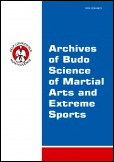2020, Volume 16, Issue 1
Ultimate Full Contact offensive efficiency analysed through styles and combat distances: a confluence of cognitive and ecological approaches
Fernando Loio Pinto1, Henrique P. Neiva1, Célia Nunes1, Luís Branquinho1, Ricardo Ferraz1
1Sports Sciences, University of Beira Interior, Covilhã, Portugal, Portugal
Author for correspondence: Ricardo Ferraz; Sports Sciences, University of Beira Interior, Covilhã, Portugal, Portugal; email: ricardompferraz@gmail.com
Full text
Abstract
Background & Study Aim: Ultimate Full Contact is a hybrid combat sport where offensive efficiency takes on an important role during a fight. However, to the best of our knowledge, no study has investigated the impact of offensive efficiency based on combat style and distances. Thus, the study aimed is knowledge about the offensive efficiency related to distances, styles, skills and their interrelationships during combat.
Materials & Methods: One hundred seventy fight DVDs were observed, integrating (n = 340) senior male athletes who participated in the WUFC World Championships. Technical-tactical attacks made and effective, between winners and losers, with different combat styles and distances were they used to analyse the difference between winners and losers and different combat styles, through the Kalina method for the combat dynamics analysis (only offensive efficiency index), Mann-Whitney U and Spearman’s bivariate correlation.
Results: The results indicate that winners had significant advantage in all offensive skills regarding the different combat distances and styles. Generally, striking skills were more efficient than submission grappling. Higher correlations were shown between specific distances and specific styles.
Conclusions: The winners attacked more and more effectively and showed greater efficiency, stability, versatility, adaptability and opportunity seizing. The biggest difference of winning or losing effect depends mainly on ground fighting (in horizontal posture), however the stand-up punching and kicking are also relevant. It is not enough to react spontaneously according to the contextual opportunities without cognitively perceiving, interpreting and deciding on specific and certain actions at the right time, articulating styles with distances.
Key words: technical-tactical skills, combat sports, combat dynamics analysis, attack





